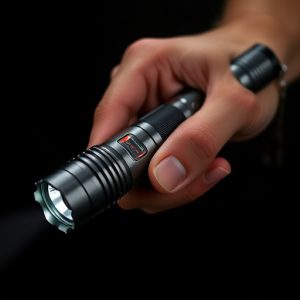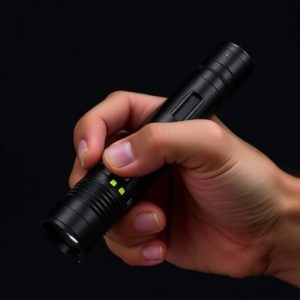Illuminating Self-Defense: Mastering the Flashlight Baton for Protection and Safety
The article provides a comprehensive overview of the self-defense flashlight baton, a versatile too…….
The article provides a comprehensive overview of the self-defense flashlight baton, a versatile tool that combines a high-lumen flashlight with an impact baton for personal safety. It serves as a non-lethal means to handle threatening situations by temporarily blinding assailants and providing an opportunity to flee or defend oneself with the baton's impact end. The device's effectiveness is contingent on factors such as brightness, reach, impact force, durability, ease of use, and proper training. Users must consider the baton's materials, LED light intensity, adjustable beam settings, weight, length, grip design, and legal compliance when selecting one. Mastery of using the light to disorient opponents and employing the baton for self-defense in a lawful and ethical manner is essential, as is consistent training to ensure proficiency and safety. Regular maintenance is necessary to keep the device functional during critical moments. The article underscores the importance of integrating this tool into a broader personal safety strategy that includes situational awareness and physical defense skills, while also adhering to local laws governing its use and ownership.
When it comes to personal safety, preparation and confidence in your tools can be crucial. A self-defense flashlight baton merges illumination with defensive capabilities, providing users with a versatile self-defense option. This article sheds light on the multifunctional nature of a self-defense flashlight baton, its key attributes, and the finesse required to deploy it effectively. We will also navigate the legal landscape surrounding their use, ensuring you are well-informed and prepared. Understanding the self-defense flashlight baton’s role in personal safety is paramount for those seeking an effective means of protection.
Understanding the Self-Defense Flashlight Baton: A Comprehensive Guide
The self-defense flashlight baton is a multifunctional tool designed to enhance personal safety and security. This device combines the disorienting power of a bright light with the striking capability of a traditional baton, providing users with a non-lethal means of self-defense that can be effective in various scenarios. The tactical flashlight integrated into the baton serves as a deterrent, temporarily blinding an attacker and creating an advantageous opportunity for escape or further defensive action. Its high-lumen light can disorient aggressors at varying distances, while its sturdy construction ensures it can deliver impact force when necessary. Users of this device must understand its capabilities and limitations; it is not a replacement for situational awareness and trained combat skills but rather a complementary tool that, when used appropriately, can significantly increase one’s self-defense options.
When selecting a self-defense flashlight baton, consider the brightness of the light, the sturdiness and length of the baton for reach, and its impact force for effectiveness in self-defense situations. The durability of the device is also crucial; it should withstand environmental factors like rain or extreme temperatures. Additionally, the ease of operation is paramount—the device should be accessible and easy to deploy under stress. Training on how to use the baton effectively is essential; users should practice using the light to disorient potential threats and learn proper striking techniques to maximize the baton’s defensive capabilities. Regular maintenance is also necessary to ensure that the flashlight and striking surfaces remain operational when needed most. Understanding the self-defense flashlight baton and its applications can empower individuals to make informed decisions about their personal safety tools, ensuring they are prepared to protect themselves should the need arise.
Key Features to Look for in a Self-Defense Flashlight Baton
When selecting a self-defense flashlight baton, it’s crucial to consider several key features that contribute to its effectiveness and safety for use in potentially dangerous situations. Firstly, durability is paramount; the baton should be constructed from high-quality, impact-resistant materials such as aluminum or titanium to withstand rough handling and maintain a sturdy structure under pressure. Secondly, luminosity is a significant factor—opt for models that offer a bright LED light capable of disorienting an assailant at night or in dimly lit environments, enhancing your visibility and striking capabilities.
Additionally, the beam intensity should be adjustable to conserve battery life when full brightness isn’t necessary and to provide various lighting options for different scenarios. The baton’s length and weight must be balanced to ensure it is not too cumbersome yet still provides enough reach and impact force. A reliable grip is also essential, as it allows for a firmer hold during confrontations, reducing the risk of the baton slipping from your grasp. Lastly, the impact end should be designed to maximize defense capabilities without causing undue harm. It’s important to evaluate the effectiveness of the striking surface, whether it be a blunt end or a spike, and its ability to deter aggressors while adhering to legal self-defense standards. Consider these features when choosing your self-defense flashlight baton to ensure you have a versatile and dependable tool in critical situations.
Effective Techniques for Using a Self-Defense Flashlight Baton
When it comes to effective techniques for using a self-defense flashlight baton, understanding both the tactical and legal implications is crucial. The first technique to master is the proper grip; hold the baton firmly but not so tightly that you hinder your agility. A two-handed grip allows for more control and force when striking, which is essential for disorienting an attacker or signaling for help. The beam of light can be used to temporarily blind assailants, creating an opportunity for escape or to deliver precise strikes with the baton itself.
In addition to the disabling effects of the light, the baton’s length and sturdy construction add impact force to your blows. Aim for bony areas such as the knees, elbows, temples, and joints, as these are likely to cause pain or incapacitate an attacker without causing fatal injury, which is a significant consideration in self-defense situations. Practice striking with both the lit end and the blunt edge, as each can serve different purposes: the lit end for disorienting and the blunt edge for striking. Consistent training with a self-defense flashlight baton will improve your response time and accuracy when faced with a threatening situation. Always prioritize de-escalation and escape where possible; the baton is a tool for self-protection, not a weapon for aggression.
Legal Considerations and Best Practices for Owning and Using a Self-Defense Flashlight Baton
When considering a self-defense flashlight baton, it’s imperative to be cognizant of the legal framework governing their use and ownership. Legislation varies by jurisdiction, so one must verify local laws rigorously. In many regions, these devices are subject to strict regulations due to their potential as both a light source and a defensive tool. Owners should familiarize themselves with the specifications that define what constitutes an acceptable self-defense baton, including length and lumens, to avoid legal infractions.
Best practices for owning and using a self-defense flashlight baton extend beyond mere legality; they encompass responsible behavior and situational awareness. It’s prudent to use the device solely in legitimate self-defense scenarios. Training is also a critical component, as it ensures proficiency in deploying the baton effectively while minimizing risks of accidental injury or misuse. Regular maintenance checks should be conducted to ensure the baton remains in optimal condition, with both its light and striking capabilities functioning correctly. Additionally, individuals should be aware of the implications of using such a device, including the potential for escalation of violence, and strive to use it only when there are no other alternatives to ensure personal safety.
Remember to adhere to the legal guidelines specific to your locale and to practice with your self-defense flashlight baton to become adept at its use should the need arise. Safe handling and storage are also non-negotiable to prevent unauthorized access and misuse. By understanding and respecting both the legal and ethical dimensions of self-defense flashlight batons, users can better protect themselves while complying with the law.


